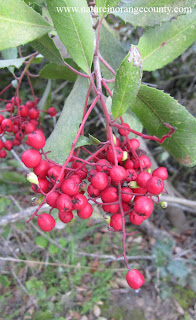Laguna Canyon Foundation just hosted their latest Volunteer Orientation at the Nix Nature Center this past Saturday, March 13th, 2010. We are so happy to have the newest volunteers-in-training on board and look forward to getting to know them better! For any information on the volunteer or naturalist programs at the Laguna Canyon Foundation, please contact Kimberly Leeds, head of education, at education@lagunacanyon.org .

Last month, on 15 February 2010, I was able to squeeze in a little hike at Aliso and Wood Canyons. I checked up on the Wood Canyon Trail and came across a whole bunch of different fungi, which I know nothing about, but which looked pretty awesome! :) Some Toyon berries were still hanging on the branches of our Toyon shrubs. Fuschia-flowered gooseberry was in bloom, and milk maids were lining parts of the trails.








Yesterday, Sunday 14 March 2010, I did a much larger hike, starting at Lower Laurel, up to Bommer Ridge, all the way to El Moro Ridge (Crystal Cove State Park), then back down to Bommer, to Willow, down to the Willow Staging Area parking lot at LCWP. The weather was absolutely perfect! Beautiful blue sky, temps in the high 60s, clear skies with 360-degree views of snow-capped mountains and Catalina Island & the beautiful blue Pacific Ocean. Photos with a JH in the watermark were taken by our lead canyon photographer Mr. Hoof.







Much is in bloom currently along the trails visited, including, but not limited to:
Chapparal Nightshade
Milk Maids
Paintbrush (along Willow)
Coast Live Oak! :)
Popcorn Flower
Red Maids
Common Deerweed (so often in bloom :) )
California Plantain
Miner's Lettuce
Fuschia-flowered Gooseberry
California Buttercup
 Blue Dicks
Blue Dicks Common Fiddleneck
Common Fiddleneck
Encelia californica
 California Manroot / Wild Cucumber - also well into the fruit stage
California Manroot / Wild Cucumber - also well into the fruit stage Canyon Pea
Canyon Pea

Prickly Pear Cactus


California Poppies


Sticky Monkey Flower

In bud only:
Blue-eyed Grass.
English plantain.
The Lupines along Lower Laurel in the shaded oak woodlands - though many lupines have already bloomed along the 133.
Poison oak was rather well leafed out in the oak woodlands.
Calif. False Indigo is just starting to leaf out, it's still pretty sparsely leaved.
The lance-leaved dudleya along the beginning of Lower Laurel is developing its flower stalks.




















